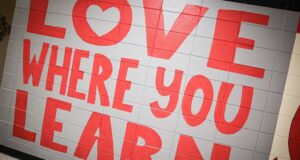Puzzle of Practice
 In their own words, Mayo Elementary School (MES) welcomes students and their caregivers into a “small, yet close-knit, school atmosphere”. Learners benefit from time in a community in which they build lasting relationships with teachers and staff that they pass in the halls every day. However, their smaller size limits their access to resources other schools might enjoy which makes it even more important that they grow their expertise from within.
In their own words, Mayo Elementary School (MES) welcomes students and their caregivers into a “small, yet close-knit, school atmosphere”. Learners benefit from time in a community in which they build lasting relationships with teachers and staff that they pass in the halls every day. However, their smaller size limits their access to resources other schools might enjoy which makes it even more important that they grow their expertise from within.
Like many schools across the country, Mayo saw a drop in end-of-grade test scores on their state-wide SC Ready English Language Arts (ELA) Assessment during and after the pandemic. More troubling to the school community was a drop in the quality of student work and enthusiasm of students. In discussion with the teachers and the instructional leadership team, it was shared that many students appeared to lack confidence in their ability, especially when it was time for them to write for any purpose.
Collective Goal
The leadership team decided to focus on improving learning in literacy and in writing in particular. To achieve their goals they decided to focus on student ownership of learning in writing. The staff believed that increasing student ownership of learning would boost students’ confidence, or efficacy, support students’ independence, and increase performance in both reading and writing.
Collective Action
Mayo selected the 2nd grade team to begin the process and serve as a model for their colleagues. Working with consultant Isaac Wells, they outlined a plan of attack to ensure all students in the grade, and later the school, would have clarity regarding the expectations of grade-level writing, including how to write in response to texts. Over time, their work expanded to include key reading comprehension standards
- The team unpacked the 2nd grade narrative writing standards as well as key language standards for conventions and created a vertical learning progression to map out learning for all children in their classes.
- They pulled writing samples and used the calibration protocol to come to a consensus on what grade-level writing “looks like”. Using this consensus, they created new rubrics and checklists to strengthen feedback and goal-setting and to raise overall expectations for writing. During future visits, teachers repeated the process with each genre of writing including responses to text called Text Dependent Answers (TDAs).
- The team was unsure how students would respond to the co-construction process, so they identified smooth transitions within the classroom as an urgent need, and pushed into a classroom for a model lesson in which students co-constructed criteria for various transitions.
- The team joined a class on a later visit to co-teach co-construction of criteria for informational writing after teachers created a progression, checklist, rubric, and annotated examples. After this, teachers took over the co-construction process with support from their instructional coach, Julie Vinesett.
- Once teachers had partnered with students to co-create clear expectations for each type of writing, they focused on writing conferences focused on the agreed-upon criteria. As students made leaps in writing (many were unable or unsure of how to even begin writing on their own early in the year), teachers were ready to move to self-peer assessment.
- The TLT pulled in learners from each class and, after a quick model mini-lesson/fishbowl on how to use their checklist and sentence frames for “Glow and Grow” feedback, each team member provided “feedback on feedback” on students’ first attempts at first assessing their own work and then the work of their peers.
- The final piece of the puzzle was to engage students in setting and monitoring specific, personal goals. Focusing feedback with teachers and peers on these personal goals in small group and individual conferences accelerated learning across the board.
- The instructional leadership team spread the work to the grades above and below the 2nd and 3rd grade model teams and their students. Each year learners were more ready to engage in co-construction, self- and peer assessment, and revision of their work and strategies, and growth accelerated each year.
Collective Impact
 After multiple years engaged in the work, teachers report a high level of clarity of expectations, including with their newly revised reading and writing standards. Students can articulate (in age-appropriate language) their goals and next steps using a combination of learning progressions, checklists, exemplars, and other tools they have created with their teachers.
After multiple years engaged in the work, teachers report a high level of clarity of expectations, including with their newly revised reading and writing standards. Students can articulate (in age-appropriate language) their goals and next steps using a combination of learning progressions, checklists, exemplars, and other tools they have created with their teachers.
Writing samples pulled from across the years show a clear shift in quality, including elaboration with pertinent details, and the progress carried over into reading comprehension.
MES celebrated significant growth in ELA scores after three years as they built back stronger from the COVID19 pandemic.
Specifically, SC Ready ELA scores grew an average of 18% as students benefited from the compounding effects of increased student ownership of learning throughout the years:
- 6% in grade 3,
- 23% in grade 4, and
- 26% in grade 5
Let’s have a virtual round of applause for the hard work and dedication of the students and staff of Mayo Elementary!

